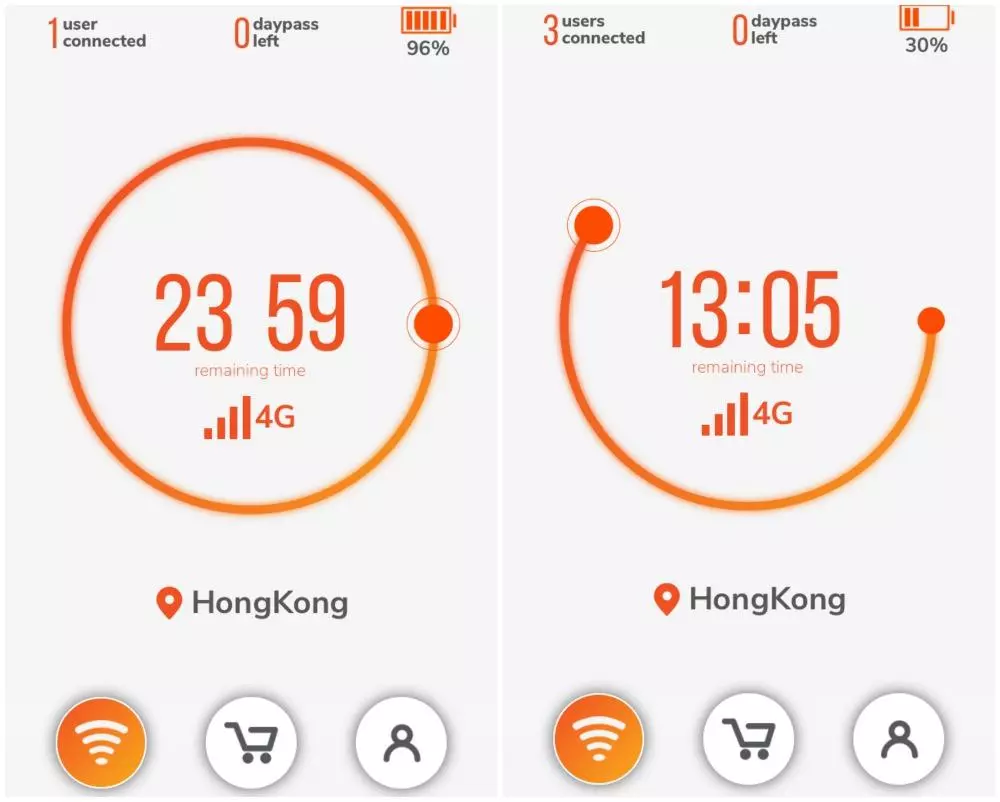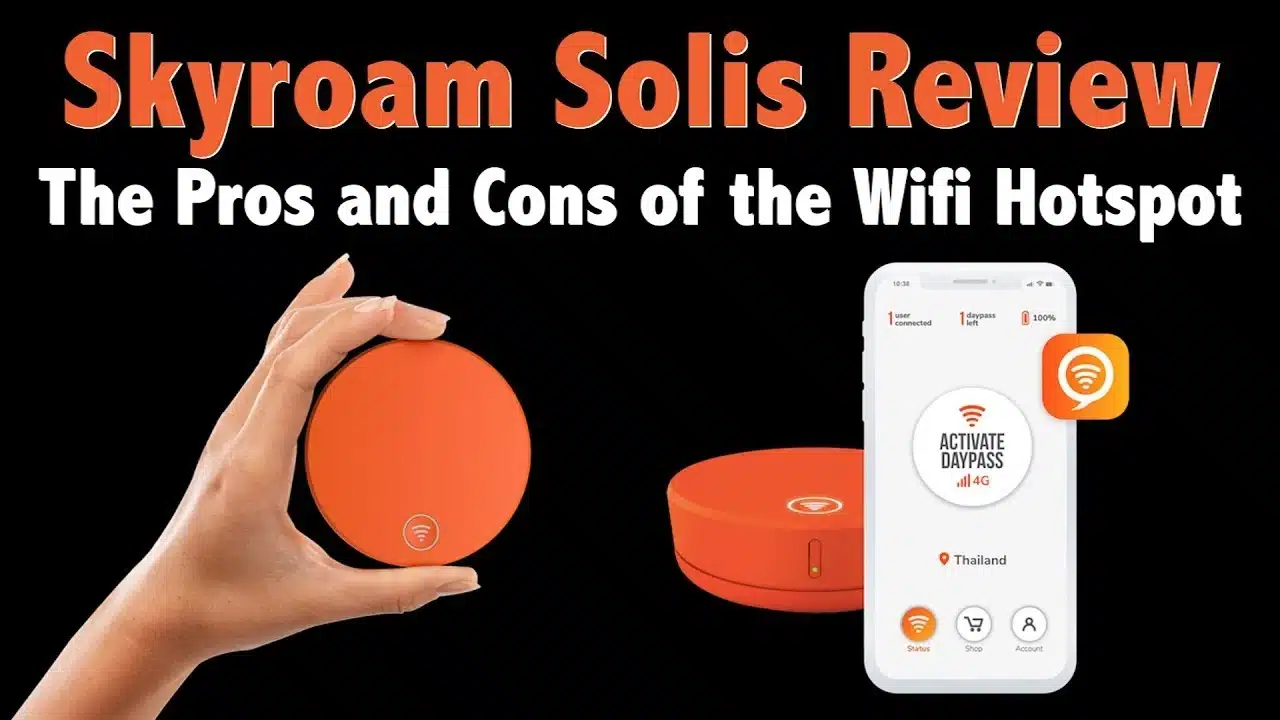
Travel Tips
2024 Solis WiFi Hotspot Review: Using the Skyroam Solis Lite Overseas
As someone who regularly “workations” and relies on a solid Internet connection to be productive while traveling, it’s kind of crazy that I went without a WiFi hotspot for so long. That’s mostly because I had never come across a particular device that jumped out at me.

Well, that was until my first CES when I happened to come across the Skyroam Solis — which is now better known just as Solis under the SIMO banner.
Incidentally, after taking a closer look at the Solis and its bright orange casing, I have to imagine I’d encountered the Skyroam company before. In any case, after speaking to their representatives at the show and later doing some of my own research online, I ended up buying a Solis in anticipation of my then-upcoming travels.
Now, having taken more than a few trips abroad with the Solis by my side, I’ve discovered some of the pros and cons of the service. So how did it hold up to my WiFi demands? Let’s take a closer look at the Solis Lite, SIMO’s international data options, and more.

- Offers affordable WiFi in more than 135 countries
- A variety of data plans are offered
- Device can also be used as a battery pack
- Day Pass plans may be subject to throttling after data maximum is reached
- New Solis 5G device is pricey
- May not be used on cruise ships, planes, or remote locations
Purchasing and Setting Up Your Solis Device
Device options
Since purchasing my original Solis device, SIMO has released a series of updated models. Currently, their line up includes two options: Solis Lite and Solis 5G.
Starting with the latter, the Solis 5G has a quoted battery life of 24 hours, supports up to 16 simultaneous device connections, and doubles as a power bank. As the name would indicate, it’s also capable of supplying 5G and 4G LTE connections. The downside? It retails for $399.99.
Turning to the Solis Lite, this model is much closer to the original Solis device and supports 4G connections. The Lite allows for up to 10 device connections at a time and has a 4700 mAh power bank. Also notable is that Lite is true to its name in that it weighs in at just 4.9 ounces and measures less than an inch in height. Currently, the Solis Lite model retails for $159.99.
Back to our regular programming: Because I only own a Solis 1, for the rest of this review, I’ll be focusing mostly on the Solis Lite, which provides a very similar experience in a smaller package.
Buying the Skyroam Solis
As I noted, the Solis Lite device costs $159.99 on the Solis site at this time. That does include free shipping, which is definitely helpful. On top of that, Solis devices now includes 1 GB of global data each month, so it’s ready to go right away.
If you are interested in purchasing a Solis, I was able to secure a 10% discount for my readers. Just click the button below and enter the code MONEY30 to get your discount.
Setting up your device
Once your Solis arrives, getting it ready to use is fairly simple. First of all, the Solis utilizes clever packaging to walk you through how to turn on and activate the device. Most of this is done through the Solis app, which you can find in the App Store or on Google Play. This app is also where you can manage your Solis account, monitor your device connection, and more.
I did run into one minor snag when I was attempting to connect my Solis for the first time. As I was trying to login, it was saying it was connecting but nothing happened. Luckily, after closing the app and reopening it, I was able to login without issue and then could easily cash in my day pass and get started on WiFi.
Plus, I also discovered that you can access a similar interface for your device by going to a.skyroam.com in your mobile browser. This URL now forwards to Solis.SIMO.co/login, so I suppose you can just go directly there as well.
Connecting to your Solis
Previously, in order to get started with your Solis device, you’d need to purchase data. Thankfully, Solis now includes 1 GB of global data per month with its new devices — including the Solis Lite. You can activate your plan in the app. Then, once the network is live, you can connect using the network name and password found on the bottom of your device.
As a reminder, the Lite allows you to connect up to 10 devices to the same network, so if you have other travelers in your party feel free to share this info with them as well.
How Solis data works
It’s important to understand how Solis hotspot devices actually work. Basically, your Solis device will connect to local 4G network(s) in order to provide you with a WiFi connection. Because of this, if you’re in an area where cellular connection isn’t possible (including on a plane or cruise ship), your device won’t be able to work properly either.
My Experience Traveling with the Solis

Not long after purchasing my Solis, I had the good fortune of visiting Hong Kong. While this was my first time getting to try out T-Mobile’s free international capabilities, I was also excited to activate the Solis I purchased shortly after CES 2019. As luck would have it, the perfect opportunity to test the device arose while my wife and I were at Hong Kong Disneyland.
Connection speed on mobile
During my visit to the park, I needed to upload a video I had shot of the new Ant-Man and the Wasp rides. Unfortunately, even with my T-Mobile One Plus plan, my regular mobile data speed wasn’t cutting it. So that’s when I knew it was time to bust out my Solis, cash in an Unlimited Global WiFi day pass and see how Solis performed. Thankfully, the WiFi the Solis provided helped my upload move along at a much faster clip and was completely uploaded within a few minutes.
Battery life
Although that task was my main concern, with my day pass activated, I figured I’d leave the Solis on to see how the battery would hold up to a day at the park. To my (somewhat) surprise, it managed to last through the whole thing and still had plenty of charge when we arrived back at our hotel room. Specifically, it went from 96% to 30% over the course of 10 hours under consistent use.
Device temperature
Speaking of “consistent use,” I was also impressed by how literally cool the Solis stayed. I’ve heard complaints about hotspots getting too, well, hot — but I kept my device in my bag the entire day and could barely notice a temperature difference when I touched it. Granted, my bag was fairly roomy and airy so it may have been a bit of a different story had it been in my pocket but, nevertheless, it was nice to know I didn’t have to worry about it overheating.
Power bank usage
Something that Solis has boasted about since the beginning is that, in addition to being a mobile hotspot, their devices also be used as a power bank. Therefore, when my phone needed a bit of charge, I once again turned to the Solis for testing.
At first, I thought I might actually be out of luck as I had forgotten to pack the USB-C to USB adapter that comes with the device, but I actually had an Apple dongle in my bag that did the trick. Still, I have to admit that my experience left something to be desired.
First of all, while I neglected to time my before and after battery level, it seemed that my iPhone charged fairly slowly while connected to the Solis. Conversely, the battery level of the Solis dropped considerably faster while I was charging my phone than when it was only doing single duty as a hotspot.
For those reasons, while it’s nice to know the Solis has power bank possibilities if you need them in a pinch, if your main concern is WiFi, I’d pack a dedicated charger instead.
Connection speed on desktop
When I returned to my hotel room, despite having WiFi, I decided to try out the Solis’s connection on my laptop. While it didn’t feel as speedy as on my phone (probably because I’m more used to waiting for things to load on mobile), it was capable of streaming YouTube without issue.
Additionally, this connection test on my laptop came as we also had both of our mobile phones still connected to the network. Admittedly, I didn’t run too many other speed tests as I was exhausted from my day walking around a theme park, but I can report my speed sampling provided satisfactory results.
Other Solis WiFi Hotspot Data Options
Although 1 GB of global data per month is now included with new Solis device purchases, there are other data options if you need to top-up. Additionally, these plans are still available for older devices such as my Solis 1.

Day passes, monthly passes, GoData, and Pay-Per-GB
In addition to their $9 per day Unlimited Global WiFi option, SIMO also offers a $99 per month option. Similar to how your day pass is good for 24 hours from when you activate, a month pass is not a calendar month but, instead, allows you to use your hotspot as much as you want during a 30-day timeframe. Be aware that this plan will auto-renew every 30 days if you don’t cancel — and there are some throttling limitations, which we’ll touch on in a moment.
Doing some quick math, if you plan on using your hotspot for more than 11 days in a month’s time, this plan will save you a bit of money compared to the per day price. Meanwhile, if you’re staying in the U.S. and still need portable WiFi, Solis now also offers an $89 domestic monthly data plan.
Another option is Solis’ GoData plans. For $8 a month (which is actually a price drop!), you can utilize 1 GB of data on your hotspot in any country Solis supports. If you need more than that, you can purchase additional gigs. While GoData plans will renew automatically, you can cancel at any time.
Not to be confused with the GoData plan, Solis also offers Pay-Per-GB offerings. In this case, you’ll pay $12 for 1 GB of global data, $55 for 5 GB, $100 for 10 GB, or $180 for 20 GB. In this case, your data will not expire and there’s no recurring charge.For context on how much 1 GB of data is, I used just under a gigabyte during my day in the park — but that’s mostly because I uploaded a 545 MB video. Therefore, if you’re using the hotspot with some discretion and, you know, not Dropboxing HD videos on a regular basis, you can make your money’s worth of data go much further.
Throttling and slower connection speeds
Something important to note about Solis’ unlimited plans is that they are subject to slower connection speeds or “throttling” should you consume more than 20 GB of data during the month. These limits are apparently not put in place by SIMO themselves but by the carriers whose networks they utilize.
Previously, I was also told that there may also be a 1GB per day cap — though, in less congested areas, users might be able to consume more before experiencing diminished speeds (technically the site says “High-speed data limits are based on the country”). In any case, if you do reach these limits and do not want to deal with slower speeds, you can add additional gigabytes of high speed data for an additional fee.
On a trip to France, I actually encountered this throttling issue for myself. Somehow I blew through my 1 GB and, soon after, my connection was rendered all but unusable. Thankfully, things were reset for the next day and my speed returned to normal.
Personally, because of the potential for throttling, I’ve become a bigger fan of the GoData plans myself.
This is especially true in Europe where you can get 1GB for $6 instead of the regular $9 (although, SIMO now makes you verify your phone number in the app to get local pricing so I’m unclear whether I could prepurchase a Euro GoData plan and redeem it). Of course, if you do sign up for a GoData plan, just be sure to cancel it unless you want to renew it for another month.
This is where Solis’s Pay-Per-GB options come in as well. According to the company, data purchased in this manner is always full speed and never throttled. So, if you’re concerned about speed and don’t want to worry about auto-renewing GoData plans, then this may be the best pick for you.
Rentals
Finally, I’d be remiss if I didn’t mention that Skyroam previously had hotspot rentals available. Under these plans, you could rent their Solis 1 device for $8.99 a day, which included your data and free standard shipping in the United States. Alas, as of July 2021, Solis is no longer renting devices. Similarly, the Solis 1 devices that were used for rentals and returned for sale are not available for purchase anymore.
While it’s slightly disappointing that the company is no longer renting devices, buying a Solis Lite was typically a better bet in the long run thanks to the 30 day Unlimited Global WiFi deal as well as the GoData option — the latter of which wasn’t available for rental devices. Still, the discontinuation of this option is a blow to those who like to try before they buy.
After years of considering different WiFi hotspot options, I’m glad that I found the Solis. While the devices are a bit of an investment upfront , the various data plan options make it so the device can easily fit your travel needs. Plus. now that the device itself includes 1 GB of global data per month, it makes it even easier to recommend.
Personally, I’ve been using the Solis as a backup for the times when my hotel WiFi lets me down or when I inevitably need to work while visiting a Disney theme park.
What’s also interesting about Solis is the variety of data options they now offer.
I’d be most inclined to go with the Pay-Per-GB plans so that I don’t need to worry about throttling or recurring charges. I might even consider purchasing a bulk of data so I can have it ready for future travels and save money in the long run. This also makes the most sense given the allotted 1 GB per month.
In any case, if you’re looking for a WiFi hotspot to take along on your international travels and that has plenty of data options, I can honestly recommend Solis devices.
Solis devices utilize various cellular networks, allowing users to create a private WiFi network. Solis offers data plans by the gigabyte as well as unlimited daily and monthly passes.
Solis’ daily and monthly unlimited plans are unlimited. However, users may experience slower connection speeds if they surpass a certain data usage (typically 1 GB) in a day or 20 GB of data in a month.
No. Solis relies on cellular connections to offer Wi-Fi, which is not possible on an airplane.
Solis has GoData plans starting at $6 a month for the U.S. and Europe or $8 a month for worldwide service. Unlimited plans start at $9 a day. There are also now Pay-Per-GB plans that cost $12 per GB for international data.
Solis offers a password-protected, private network so it is secure.
If no cellular connection is available, then Solis Wi-Fi unfortunately won’t be able to connect either.
Solis supports VoIP (voice over IP) calls but their plans only offer data, not phone service.
Leave a Reply
You must be logged in to post a comment.





Does Solis work in every country or there are predetermined countries that it will work? Thanks
Skyroam says the hotspot should work in more than 130 countries. They also have a tool on their site that will tell you if the place you’re traveling to is supported or not: http://www.skyroam.com/how-it-works Hope that helps!
This can be a great travel companion. No need to buy a local sim in the country I am going to.
Definitely, a must have if you are a frequent traveler abroad. Saves you the hassle of looking for a wifi connection wherever you go.
Having it for rental is a bright idea for Skyroam. Users can try it out without purchasing it or just for a short period of time.
Great product until you need customer service. I bought 1 GB for August, 2019 and they also billed me for Sept, 2019 as well claiming that I bought a renewable monthly program which I did not since I don’t need their product at home. They would not cancel the extra month so I had to make a claim to my credit company for the $9.00. They would not cancel the monthly subscription they claimed I had so I had to figure out how to do it myself. So for $9.00 they turned a good customer, who has recommended them into a disatisfied one. I’ve had the product for 9 months and it worked as it was supposed to.
Ugh that is frustrating. Unfortunately the GoData plan does default to a subscription so you do need to cancel it (I canceled it right after activating it so I didn’t forget). Still, I’m surprised they wouldn’t reverse the charge for you once you noticed it.
Thanks for the review. I am helping our friend get the Solis lite for their upcoming travel. Once the device and the app set up on the phone, how easy is it for you to connect once you get to a different country? If we sign up for the Go Data at 1GB per month and used it up before the end of month as you did :), do we then just buy another 1GB plan? It’s a monthly subscription, so I wasn’t sure how it works. Thank you!
Thanks! Yes, I believe you can just add additional GBs if you run out and it should just renew at the 1GB level the following month. However, I’d double-check what your plan says before the renewal date and adjust if needed.
Thanx for the thorough revu! Ill probably buy the Solis Lite – I went to Japan in 2019 and rented their portable wifi .. omg it kept running out of power, i had to use my battery charger [which was meant to charge my fone] to charge their portable wifi!!! And it was running very hot (temp) … Im just afraid after i buy it, 5G will take over and ill have to buy another one!! I will be going back to Japan again in 2020 – this time ill be better prepared!! danke
This is interesting and can be an essential device for traveling, not only wifi on the go, but also can be an emergency power bank.
A very convenient travel buddy. Internet on the go is ideal for the frequent traveler or those who work from the road.